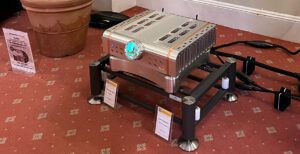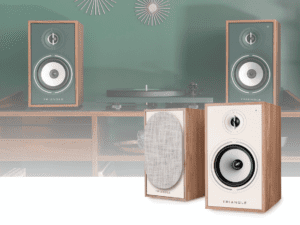
Back in 2009 (which in computer years is like saying ‘back in 1609’), High Resolution Technologies launched its first USB-powered Streamer DAC at an incredibly keen price. This was one of the first dedicated USB-based digital converters launched. Five years on, and the Streamer III has is a different device in many respects, but retains a lot of its original features (and colour scheme). However, where five years ago it had the market almost all to itself, now it re-enters one of the most fiercely fought sectors of audio, where history counts for nothing and no quarter is given. Is the HRT concept still competitive?
In many respects, the world has changed and stayed the same over the last five years. Our ears have not changed, and the performance of the DAC has improved in an evolutionary rather than revolutionary manner. So, the second version of the HRT Streamer got asynchronous USB transfer, and this one brings galvanic isolation of the USB input, and essentially brings Streamer II+ performance to a lower price. Physically, the Streamer III similar to its predecessor, but with grey instead of colour-coded end cheeks. It supports Class 1 USB, meaning there’s no need for additional drivers for Windows users; it works out of the box. Or, in my case, the bubble-wrap: it’s difficult to do an unboxing of a product that came as a pre-release without box, manual or stick-on feet, but the product is not a ‘hot’ early model.

Class 1 USB has its obvious advantages, but it limits the output to 24-bit, 96kHz files, and the HRT Streamer III (like its forebears) has a strict 24/96 ceiling. Files with resolution beyond that ceiling can be down-sampled to an appropriate multiple of 44.1kHz or 48kHz, however, but collectors of DSD files who wish to pay them in native resolution have no digital pathway through the HRT Streamer III. This invites an interesting question; is that important? Certainly, the market for DSD-ready DACs is strong enough in some markets to make a DAC without DSD support effectively unsaleable, but this falls into a budget category where it will become effectively a USB sound card for people who might think lossless 16/44.1 is meaningless excess. Candidly, I don’t know how this will fare in such circumstances; I don’t think the lack of DSD support is a problem at this price point, but I also know there’s a strong contingent of audio enthusiasts who demand the DSD tick on the box regardless.

The sound quality of the HRT models has never been an issue, and it’s not an issue here. This is a high-end converter without the high-end price; it is detailed and dynamic, and creates a great soundstage. The III is not a revolution over the II, but it gets closer to the II+ than its predecessor. It’s still early days in performance terms, though; it’s barely had more than two albums across its DAC.

There’s one obvious test to come. Where five years ago, the HRT Streamer was in a class of its own, the Streamer III now has to go up against the market leader in this field – the Audioquest Dragonfly. How do they compare? For that, you’ll have to wait and see…
Tags: FEATURED
By Alan Sircom
More articles from this authorRead Next From Blog
See all
Audio Show Deluxe 2024: A photo show report
- Mar 28, 2024

Paul Messenger 1949-2024: A personal tribute
- Mar 26, 2024

Bristol Hi-Fi Show 2024: See You There!
- Feb 21, 2024

Triangle Borea Connect
- Feb 19, 2024










